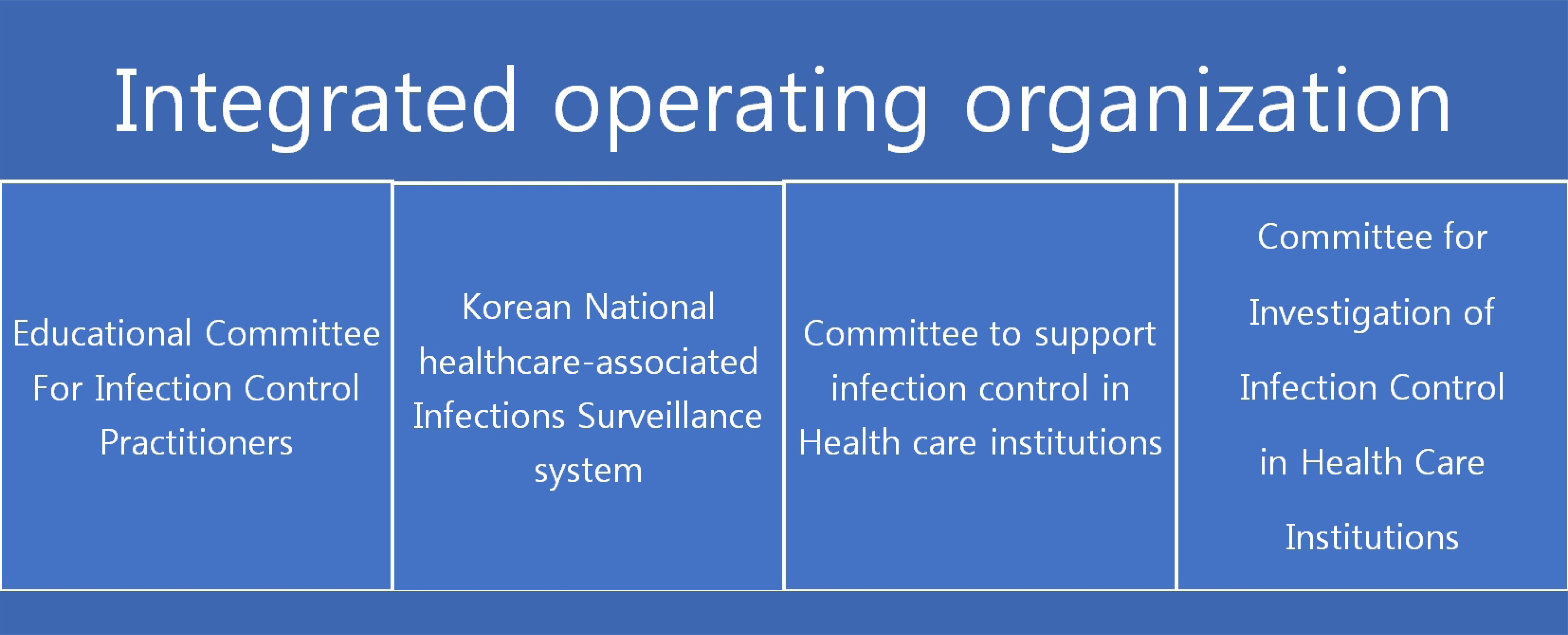Korean J healthc assoc Infect Control Prev.
2020 Dec;25(2):70-78. 10.14192/kjicp.2020.25.2.70.
The Present and Future of Infection Control Policy in Korea
- Affiliations
-
- 1Division of Infectious Disease, Department of Internal Medicine, Kangnam Sacred Heart Hospital, College of Medicine, Hallym University, Seoul, Korea
- KMID: 2510132
- DOI: http://doi.org/10.14192/kjicp.2020.25.2.70
Abstract
- There have been significant infectious disease-related issues since the outbreak of the novel influenza in 2009, the spread of Middle East respiratory syndrome coronavirus in hospitals in 2015, group deaths due to fluid contamination in the neonatal intensive care units of university hospitals in 2017, and the outbreak of coronavirus disease in 2020. However, these crises related to infection control created an opportunity for the infection control in medical institutions to become noticeable. Furthermore, it affected the development of policies and infection control fees at the government level. As infection control gains importance, discussions regarding education for increased human resources, the role and expectation of the infection control monitoring system, a support system to strengthen the infection control capabilities of vulnerable medical institutions, and an evaluation system to assess and improve the level of infection management in medical institutions have begun. This review article discusses the current situation and problems and the means to develop them in the future.
Figure
Cited by 1 articles
-
Effect of On-site Consultation and Education on Infection Control in Nursing Homes in Korea
Jong Rim Choi, Kyeong-Sook Cha, Ji Youn Choi, Si Hyeon Han
Korean J Healthc Assoc Infect Control Prev. 2022;27(1):59-68. doi: 10.14192/kjicp.2022.27.1.59.
Reference
-
1. Choi JS. 2019; Changes of the core competency of infection control nurses in accordance with the new law supporting infection control manpower. Korean J Healthc Assoc Infect Control Prev. 24:35–42. DOI: 10.14192/kjhaicp.2019.24.1.35.
Article2. Korea Human Resource Development Institute for Health and Welfare. Education for infection control. https://edu.kohi.or.kr/portal/PB/PBD/PBD0020C.jsp . Updated on 1 March 2020.3. Infection Control Consulting Network. History of Infection Control Consulting Network. http://www.iccon.or.kr/sub01/sub06.html . Updated on 31 March 2020.4. Korea Centers for Disease Control and Prevention. Infection control education course for nursing hospital workers. http://www.kdca.go.kr/board.es?.mid=a20505000000&bid=0017&act=view&list_no=366571 . Updated on 27 March 2020.5. Morikane K. 2012; Infection control in healthcare settings in Japan. J Epidemiol. 22:86–90. DOI: 10.2188/jea.JE20110085. PMID: 22307433. PMCID: PMC3798586.
Article6. Statewide Program for Infection Control and Epidemiology. History of Statewide Program for Infection Control and Epidemiology (SPICE). https://spice.unc.edu/history/# . Updated on 1 January 2020.7. Kim TH. 2020; Birth story of KONIS (Korean National Healthcare-associated Infections Surveillance System), how to improve tomorrow. Korean J Healthc Assoc Infect Control Prev. 25:1–3. DOI: 10.14192/kjicp.2020.25.1.1.
Article8. Kim YK. 2019; Perspective of nationwide surveillance system for surgical site infections. Korean J Healthc Assoc Infect Control Prev. 24:46–51. DOI: 10.14192/kjicp.2019.24.2.46.
Article9. Korea Disease Control and Prevention Agency. The pilot project for surveillance system for health-care associated infections in nursing hospitals. http://www.prism.go.kr/homepage/progress/retrieveProgressDetail.do;jsessionid=830829111335198B7FDB12EAC39C91A5.node02?.research_id=1351000-202000237&cond_research_name=&cond_organ_id=&cond_status_type=&pageIndex=1&leftMenuLevel=130 . Updated on 1 June 2020.10. Korea Centers for Disease Control and Prevention. The survey on hand hygiene (for clinics) to prevent infectious diseases in 2016. http://www.kdca.go.kr/board.es?.mid=a20505000000&bid=0017&act=view&list_no=131156 . Updated on 11 April 2016.11. Korea Centers for Disease Control and Prevention. The survey on hand hygiene (for clinics) to prevent infectious diseases in 2018. http://www.kdca.go.kr/board.es?.mid=a20505000000&bid=0017&act=view&list_no=130801 . Updated on 5 April 2018.12. Kim T, Eun BW, Hong KH, Choi HK, Kim SR, Han SH, et al. 2020; A study on the linterature search of operating systems of national healthcare-associated infection surveilance for the improvement of Korean National Healthcare-Assoicated Infections Surveillance. Korean J Healthc Assoc Infect Control Prev. 25:21–8. DOI: 10.14192/kjicp.2020.25.1.21.
Article13. Korea Centers for Disease Control and Prevention. 2020 Guidelines for healthcare associated infection prevention and management projects. http://www.kdca.go.kr/board.es?.mid=a20507020000&bid=0019&act=view&list_no=366625 . Updated on 23 March 2020.
- Full Text Links
- Actions
-
Cited
- CITED
-
- Close
- Share
- Similar articles
-
- The Recent Trend and Perspective of Infection Control in the Republic of Korea
- Management of future infectious diseases: eight recommendations for national quarantine
- A Study on the Knowledge and Performance Status for Healthcare- Associated Infection Control and Prevention in Caregivers
- The Effects of an Intensive Education Program on Hospital Infection Control on Nursing Students' Knowledge, Attitude, and Confidence in Infection Control
- Infection Control in USA and the Study on the Efficacy of Nosocomial Infection Control


